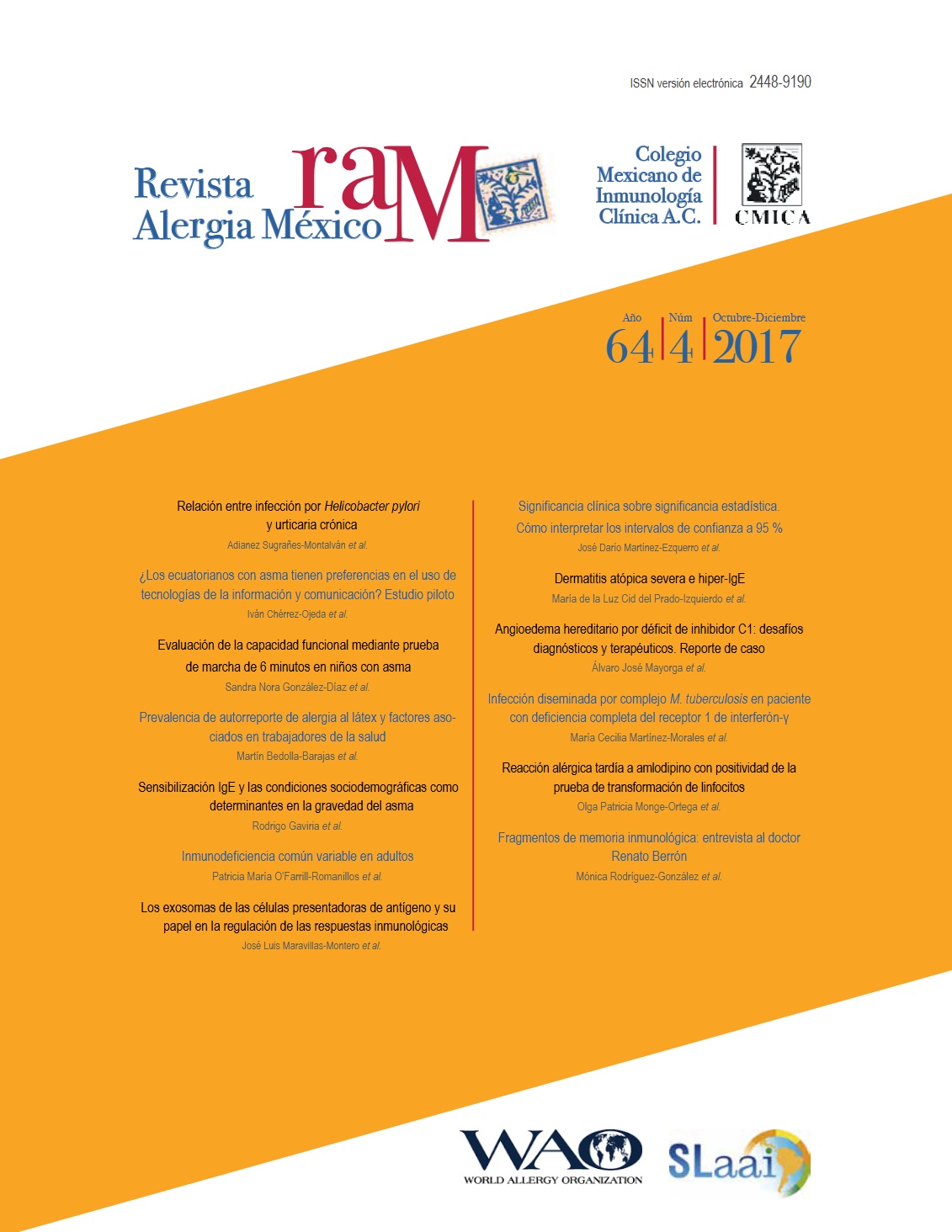Resumen
Antecedentes: pocas veces ha sido estudiada la prevalencia de alergia al látex en personal de la salud en México.
Objetivo: determinar la prevalencia de autorreporte de alergia al látex y los factores asociados en trabajadores de la salud.
Métodos: estudio trasversal de 1292 trabajadores de la salud de un hospital de segundo nivel, a quienes se les aplicó un cuestionario estructurado para identificar alergia al látex, historia personal y familiar de atopia, exposición a guantes de látex y antecedente de cirugías. La búsqueda de asociaciones entre variables se realizó mediante regresión logística. Se calcularon razones de momios (RM) e intervalo de confianza a 95 % (IC 95 %)
Resultados: la relación mujer:hombre fue de 2.4:1. Edad media de 38.4 ± 11.6 años. La prevalencia de alergia al látex fue de 9.7 %, IC 95 %, 8.1-11.3 %. No hubo diferencia estadística por área laboral (p = 0.508). Los factores asociados con la alergia al látex fueron sexo femenino (RM = 1.68; IC 95 %, 1.03-2.73), historia personal de atopia (RM = 4.82; IC 95 %, 3.19-7.26), historia familiar de dermatitis atópica (RM = 4.33; IC 95 %: 1.20-4.41) e historia de alergia a frutos (RM = 2.30; IC 95 %, 2.62-7.14).
Conclusiones: hasta 10 % de los trabajadores de la salud podría presentar alergia al látex; los principales factores asociados fueron sexo femenino, atopia personal o familiar y alergia a frutos.
Referencias
Grzybowski M, Ownby DR, Peyser PA, Johnson CC, Schork MA. The prevalence of anti-latex IgE antibodies among registered nurses. J Allergy Clin Immunol. 1996;98(3):535-544. DOI: http://dx.doi.org/10.1016/S0091-6749(96)70087-8
Gholizadeh N, Khoeini-Poorfar H, Mehdipour M, et al. Prevalence of allergy to latex gloves among dental practitioners and its association with other materials. Avicenna J Dental Res. 2011;3(1):37-42.
Yusoff A, Murray SA, Rahman NA, John J, Mohammad D, Tin-Oo MM. Self-reported latex glove allergy among dental personnel in Kelantan State, Malaysia. Int Med J. 2013;20(3):343-345.
Filon FL, Radman G. Latex allergy: A follow up study of 1040 healthcare workers. Occup Environ Med. 2006;63(2):121-125. DOI: http://dx.doi.org/10.1136/oem.2003.011460
Guzmán MA, Arancibia V, Salinas J, Rodas C, Roa J, Villegas R. Prevalence of latex hypersensitivity in operating room workers of the University of Chile Clinical Hospital. Rev Med Chil. 2005;133(5):535-540. DOI: http://dx.doi.org/S0034-98872005000500004
Amarasekera M, Rathnamalala N, Samaraweera S, Jinadasa M. Prevalence of latex allergy among healthcare workers. Int J Occup Med Environ Health. 2010;23(4):391-396. DOI: http://dx.doi.org/10.2478/v10001-010-0040-5
Phaswana SM, Naidoo S. The prevalence of latex sensitization and allergy and associated risk factors among healthcare workers using hypoallergenic latex gloves at King Edward VIII Hospital, KwaZulu-Natal South Africa: A cross-sectional study. BMJ Open. 2013;3(12):e002900. DOI: http://dx.doi.org/10.1136/bmjopen-2013-002900
Cabañes N, Igea JM, De-La-Hoz B, Agustín P, Blanco C, Domínguez J, et al. Latex allergy: Position paper. J Investig Allergol Clin Immunol. 2012;22(5):313-330; quiz follow 330. Disponible en: http://www.allergy.org.gr/KJLMOLOI/wp-content/uploads/2013/02/12.pdf
Jones KP, Rolf S, Stingl C, Edmunds D, Davies BH. Longitudinal study of sensitization to natural rubber latex among dental school students using powder-free gloves. Ann Occup Hyg. 2004;48(5):455-457. DOI: http://dx.doi.org/10.1093/annhyg/meh038
Saary MJ, Kanani A, Alghadeer H, Holness DL, Tarlo SM. Changes in rates of natural rubber latex sensitivity among dental school students and staff members after changes in latex gloves. J Allergy Clin Immunol. 2002;109(1):131-135. DOI: http://dx.doi.org/10.1067/mai.2002.120557
Galindo MJ, Quirce S, Garcia OL. Latex allergy in primary care providers. J Investig Allergol Clin Immunol. 2011;21(6):459-465. Disponible en: http://www.jiaci.org/summary/vol21-issue6-num778
Liss GM, Sussman GL, Deal K, Brown S, Cividino M, Siu S. Latex allergy: Epidemiological study of 1351 hospital workers. Occup Environ Med. 1997;54(5):335-342. DOI: http://dx.doi.org/10.1136/oem.54.5.335
Verna N, Di-Giampaolo L, Renzetti A, Balatsinou L, Di-Stefano F, Di-Gioacchino G, et al. Prevalence and risk factors for latex-related diseases among healthcare workers in an Italian general hospital. Ann Clin Lab Sci. 2003;33(2):184-191. Disponible en: http://www.annclinlabsci.org/content/33/2/184.long
Tang MBY, Leow YH, Ng V, Koh D, Goh CL. Latex sensitization in healthcare workers in Singapore. Ann Acad Med Singapore. 2005;34:376-382. Disponible en: https://pdfs.semanticscholar.org/b2e6/9c6c96a78c9d2ffd0bc46fb2dd3af5252b72.pdf
Buss ZS, Fröde TS. Latex allergen sensitization and risk factors due to glove use by health care workers at public health units in Florianopolis, Brazil. J Investig Allergol Clin Immunol. 2007;17(1):27-33. Disponible en: http://www.jiaci.org/summary/vol17-issue1-num192
Blanco-Guerra C. Síndrome látex-frutas. Allergol Immunopathol (Madr). 2002;30(3):156-163. Disponible en: http://www.elsevier.es/es-revista-allergologia-et-immunopathologia-105-articulo-sindrome-latex-frutas-13029650
Allergome. [Sitio web]. Proteins. Disponible en: http://www.allergome.org/script/search_step2.php?action = search&type_archive = &no_unknown = &only_iuis = &no_isoform = &first_archivie = 2&first_field = Actin-binding %20Proteins
Blanco C, Carrillo T, Castillo R, Quiralte J, Cuevas M. Latex allergy: Clinical features and cross-reactivity with fruits. Ann Allergy. 1994;73(4):309-314.
Garabrant DH, Roth HD, Parsad R, Ying GS, Weiss J. Latex sensitization in health care workers and in the US general population. Am J Epidemiol. 2001;153(6):515-522. DOI: http://dx.doi.org/10.1093/aje/153.6.515
Mathias LA, Botelho MP, Oliveira LM, Yamamura SJ, Bonfá RL, Marsura S. Prevalence of signs/symptoms suggestive of latex sensitization in health care workers. Rev Bras Anestesiol. 2006;56(2):137-146. DOI: http://dx.doi.org/10.1590/S0034-70942006000200005
Lebenbom-Mansour MH, Oesterle JR, Ownby DR, Jennett MK, Post SK, Zaglaniczy K. The incidence of latex sensitivity in ambulatory surgical patients: A correlation of historical factors with positive serum immunoglobulin E levels. Anesth Analg. 1997;85(1):44-49. Disponible en: http://journals.lww.com/anesthesia-analgesia/Fulltext/1997/07000/The_Incidence_of_Latex_Sensitivity_in_Ambulatory.8.aspx
Ownby DR, Ownby HE, McCullough J, Shafer AW. The prevalence of anti-latex IgE antibodies in 1000 volunteer blood donors. J Allergy Clin Immunol. 1996;9786):1188-1192. DOI: http://dx.doi.org/10.1016/S0091-6749(96)70183-5
Bernardini R, Novembre E, Lombardi E, Pucci N, Vierucci A, Marcucci F, et al. Risk factor for latex allergy in 54 children with atopy and latex sensitization. J Allergy Clin Immunol. 2003;111(1):199-200. DOI: http://dx.doi.org/10.1067/mai.2003.45
Boonchai W, Sirikudta W, Iamtharachai P, Kasemsarn P. Latex glove-related symptoms among health care workers: A self-report questionnaire-based survey. Dermatitis. 2014;25(3):135-139. DOI: http://dx.doi.org/10.1097/DER.0000000000000044

Esta obra está bajo una licencia internacional Creative Commons Atribución-NoComercial 4.0.
Derechos de autor 2017 Revista Alergia México





